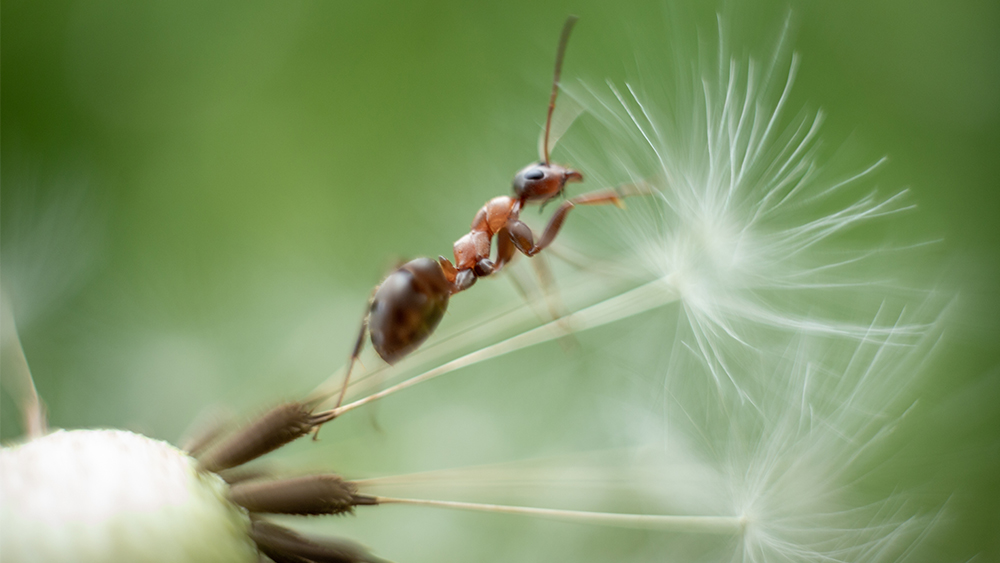The theory of evolution states that long ago, when flowering plants spread out from ancient forests, the ants followed, initiating the evolution of the many thousands of ant species found today.
Evolutionists maintain that “ants and plants have been evolving together over the past 60 million years.”1 But according to the fossil record, plants have always been plants, and ants have always been ants. In addition, there is no evidence that they have been “evolving together,” and the Earth is not nearly that old.2
Besides the origin of the eye, Darwin had a problem with the origin of flowering plants (angiosperms—plants that produce seeds within an enclosure, i.e., a fruiting plant), known as Darwin’s abominable mystery. The biblical model of origins maintains that the first forms of life created by God were land plants on Day 3 of the creation week. Land plants were fully-formed and functional—“in the beginning.”
Evolutionists must posit that there were close fossil relatives of flowering plants. But such fossils have not been found. They merely show up in the fossil record fully formed. Angiosperm origins remain contentious, uncertain, and “an intensely debated mystery.”3 Indeed, the prestigious journal Nature Ecology & Evolution stated, “Although this abominable mystery [flowering plant origin] is often cited today, and sometimes declared solved, few realize that the mystery is deeper today than it was for Darwin.”4
The picture is the same for the origin of the ant. There are over 14,000 different species of ants of the family Formicidae. As one creation scientist said,
these creatures were made to reproduce after their own kinds—only thousands, not millions, of years ago [and] is a better alternative explanation, because if each ant kind was specifically created, then the problem of unraveling their convoluted evolutionary family trees vanishes. The most straightforward explanation is that these newly-discovered ants were made by God’s design.5
Evolutionists ignore the biblical model and state ants came from an unknown, single common arthropod ancestor.
When you look around the world today, you can see ants on nearly every continent occupying all these different habitats, and even different dimensions of those habitats—some ants live underground, some live in the canopies of trees. We're trying to understand how they were able to diversify from a single common ancestor to occupy all these different spaces," says Matthew Nelsen, a research scientist at the Field Museum in Chicago...1
The biologists admit, “But exactly how ants evolved to take over the world is still a mystery.” For example, evolutionists were puzzled to find a large ant (Titanomyrma) fossil in British Columbia. The same species was found previously in Europe. How did it get to Canada?
There is no need to postulate ants trekking across the Arctic to explain the distribution. Nor is there a need to inject short “hyperthermal” episodes to allow passage from one continent to another. The global Flood explains what we observe the best. The warmer pre-Flood conditions and likely higher oxygen levels explain the large size of the ants. And their fossil distribution is best explained by their transport [by Flood water] off the highest pre-Flood hills as the waters were receding.6
Since the Flood, about 4,500 years ago, both plants and insects (i.e., ants) have been moving in and filling the many ecological niches found in the thousands of ecosystems throughout the world. Real-world ecology—such as plant and ant interaction—and paleontology supports the Bible’s trustworthiness.7
References
- “Ants took over the world by following flowering plants out of prehistoric forests, says study.” Field Museum. Posted on Fieldmuseum.org March 31, 2023, accessed March 31, 2023.
- Clarey, T. et al. 2021. Does Radioisotope Dating Prove an Old Earth? Acts & Facts. 50 (6): 18.
- Qiang Fu, Jose Bienvenido Diez, Mike Pole, Manuel García Ávila, Zhong-Jian Liu, Hang Chu, Yemao Hou, Pengfei Yin, Guo-Qiang Zhang, Kaihe Du, Xin Wang (2018) An unexpected noncarpellate epigynous flower from the Jurassic of China eLife 7:e38827
- Buggs, R. J. A. 2017. The deepening of Darwin’s abominable mystery. Nature Ecology & Evolution. 1 (6): 169.
- Thomas, B. 120-Million-Year-Old Ants Alive and Well? Creation Science Update. Posted on ICR.org Sept 24, 2008, accessed March 31, 2023.
- Clarey, T. Giant Ants Buried in Receding Flood Rocks. Creation Science Update. Posted on ICR.org March 23, 2023, accessed March 31, 2023.
- Johnson, J. 2020. Food Web Ecology Corroborates Scripture. Acts & Facts. 49 (10): 21.
*Dr. Sherwin is science news writer at the Institute for Creation Research. He earned an M.A. in zoology from the University of Northern Colorado and received an Honorary Doctorate of Science from Pensacola Christian College.





















